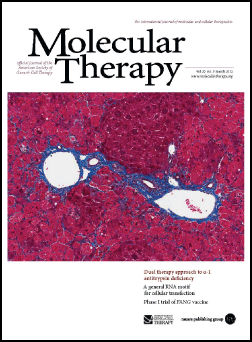 |
Research at UMass Medical School offers new evidence that a dual therapy approach for patients with alpha-1 antitrypsin (AAT) deficiency may have potential for simultaneously treating the lung and liver diseases commonly associated with the hereditary disorder. Published in the March issue of Molecular Therapy, the study describes a gene therapy treatment using a novel combination of a normal AAT gene to increase good protein levels in the lungs with a microRNA designed to suppress the toxic-forming, mutant alpha-1 gene in the liver.
AAT plays an important role in the body’s ability to turn off the immune system. Produced in the liver and delivered through the blood, the AAT protein is responsible for protecting lung tissue from inflammatory enzymes that destroy invading bacteria. Patients with AAT deficiency aren’t able to produce enough of this protective protein and, as a result, these inflammatory enzymes destroy not only bacteria and infected cells but healthy lung tissue as well. People with AAT deficiency are vulnerable to infections or irritants in the air, such as cigarette smoke, and often develop life-threatening lung diseases such as emphysema or chronic obstructive pulmonary disease.
Just as the alpha-1 protein deficiency can give rise to lung disease, the mutant gene can lead to cirrhosis of the liver. Because the mutant protein is not secreted properly in the liver, it accumulates and can become toxic. This toxicity can damage liver tissue and cause cirrhosis.
“Current treatments for AAT deficiency mostly focus on preventing the lung damage caused by the lack of this protein and have limited effectiveness for people suffering from this debilitating disease,” said Terence R. Flotte, MD, the Celia and Isaac Haidak Professor of Medicine, executive deputy chancellor, provost, dean of the School of Medicine and professor of pediatrics. “There is no long-term treatment available that can address both the lung disease and liver damage resulting from this hereditary disorder.”
The challenge for clinical scientists at UMMS was to develop a potential therapy that simultaneously increased production of functional alpha-1 protein in the blood while also suppressing the toxic mutant gene in the liver.
Previous clinical trials by Dr. Flotte have shown that patients who have had functional alpha-1 genes injected into muscle tissue using an adeno-associated viral (AAV) vector are capable of producing near-therapeutic levels of the alpha-1 protein. These trials, being conducted at UMMS, have shown promise for increasing AAT levels in patients with AAT deficiency, but like many current treatments, it doesn’t address the issue of the corresponding liver disease.
In order to suppress the mutant gene in the liver, Flotte and colleagues turned to the RNA-induced silencing complex, a natural system responsible for regulating gene function. Working with Christian Mueller, PhD, assistant professor of pediatrics, and Phillip D. Zamore, PhD, Howard Hughes Medical Institute Investigator, the Gretchen Stone Cook Chair of Biomedical Sciences and professor of biochemistry & molecular pharmacology, the UMMS team designed an artificial microRNA to suppress the mutant AAT gene in the liver. A single stranded RNA molecule, microRNA helps to control gene expression, and can increase or decrease protein levels produced by targeted genes.
Flotte and his team combined these therapeutic strategies into a single AAV vector that could be delivered simultaneously. To make sure that the artificial microRNA didn’t also turn off the normal gene being introduced, they engineered the DNA so it is resistant to the effects of the microRNA.
Results of the study show that the artificial miRNA was successful in reducing mutant AAT levels in animal models while also exhibiting sustained expression of the functional AAT gene. “The study clearly shows the feasibility of a dual-function therapeutic approach for alpha-1 antitrypsin deficiency,” said Dr. Mueller. “More work needs to be done, though, to determine what effect the expression of artificial microRNAs might have on the target organ.”
“More broadly, these findings raise the possibility that other diseases requiring augmentation of functional gene with suppression of a mutant gene, such as ALS or cerebral ataxia, might be susceptible to a similar strategy,” said Flotte